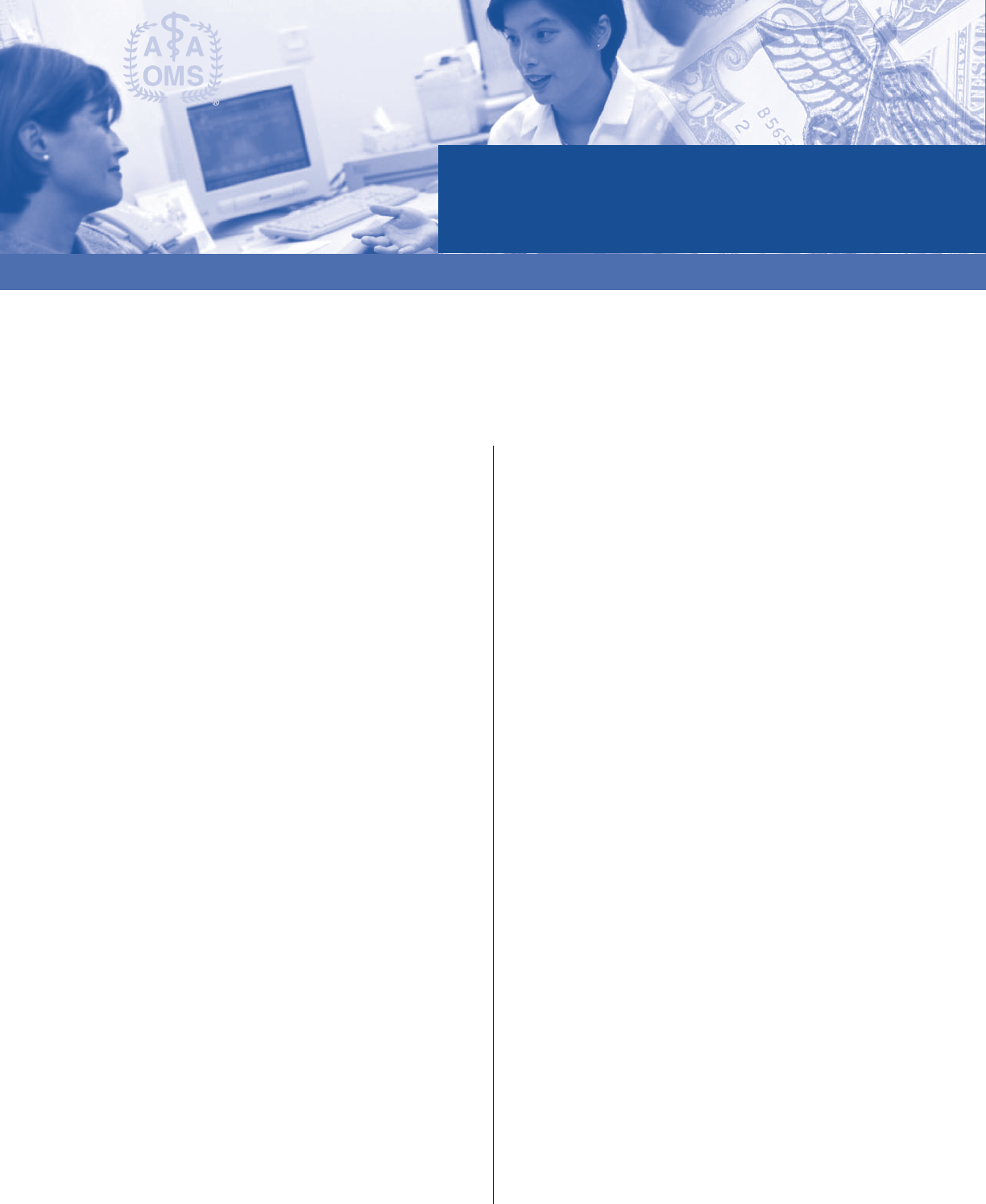
March/April 2008
1
The Electronic Medical Record
and the future of dentistry
By Bruce Lieberthal, DDS, director of Product Management for Henry Schein Practice Solutions
T
he Electronic Medical Record (EMR) is an integral
part of the medical standard of care—today and
in the future. EMR is sometimes referred to as
Electronic Dental Record (EDR) or Electronic Health
Record (EHR). This key feature guides you through
clinical record-keeping in a standard SOAP format
(subjective, objective, assessment, plan). It allows key
patient information to be centralized— demographic,
medical/dental, social and financial— all within your
practice management software. EMR eliminates multiple
paper charts and provides controlled, secure and instant
digital access to comprehensive information. Some
EMRs incorporate a range of supporting technologies
to become a fully integrated component of the practice
management software, thereby allowing even more access
to vital information at the point of care. This information
is accessible from any secure workstation, so there are
no interruptions during the patient visit to retrieve
information. Everything is at your fingertips.
The Evolution of EMR
EMR has evolved from just an idea in the 1960s into a
technical application that is changing the way the medical
and dental fields operate. Increasingly the EMR is viewed
as a mechanism to address patient safety issues and the
storage, transfer and security of medical information.
HIPAA compliance is paramount to the successful
implementation and adaptation of EMR.
Government regulations and public policy indicate
that the adaptation and implementation of Health
Information Technology (HIT) set the foundation for
healthcare reform. Leading the way for reform is EMR’s
universal use. The Department of Health and Human
Services projects that the majority of Americans will
have an electronic medical record by 2014; the federal
government is also set to make EMR a mandated practice
in health care sometime between 2011 and 2014.
This HIT mandate alleviates many issues involved with
traditional, paper-based medical records:
• Data can only be viewed/used by one person at a
time.
• Data may be illegible or misinterpreted.
• Data can be lost—pages can fall out of the file—
and charts can be misplaced.
• Data can be difficult to locate in large
charts/files.
• Data cannot easily be cross-referenced across charts.
• Data is not readily structured.
• Data does not easily support point-of-care decision-
support logic.
• Important and often subtle patterns in the data are
not apparent.
• Availability of electronic connectivity to other
technologies and databases does not exist.
• Data is not secure.
• Data is not widely available.
EMR represents a more evolved way of recording patient
information. It is a completely digital format, where the
doctor is able to assess outcomes and data points, not
just create a textual, paper record. Information can be
stored and shared with patients and other consulting
healthcare providers on a particular case, including the
exchange of information via the Internet.
The evolution of EMR also enables the use of multiple
digital technologies. It is expandable, and easily
incorporates other technologies. EMR is one of many
digital technologies that are advancing the practice of
medicine.
A digital practice begins with a comprehensive practice
management system that encompasses EMR technology.
Without the electronic medical record, the records exist
Practice ManageMent
Notes
A Supplement to the AAOMS Today Newsletter March/April 2008

2
March/April 2008
AAOMS
PRACTICE MANAGEMENT Notes
on paper, and true digital efficiencies cannot be realized.
Combined with other embedded technologies, such as
the capabilities to verify insurance eligibility online,
run credit card payments, etc., EMR can permanently
transform your clinical world.
History of Medical/Electronic
Record Keeping
Historically the patient medical record has required
significant time to complete and has been almost
exclusively on paper. This paper-based diary has logged
medical events as they occur, along with patient data in
various charts and forms.
In the 1960s, a physician named Dr. Lawrence L. Weed
first described the concept of computerized, or electronic
medical records. Weed described a system to automate
and reorganize patient medical records to enhance their
utilization and thereby lead to improved patient care.
Dr. Weed’s work formed the basis of the PROMIS
project, started in 1967 at the University of Vermont; it
was a collaboration among physicians and information
technology experts, to develop an automated EMR
system. The objectives were to develop a system that
would provide timely and sequential patient data to the
physician, and enable the rapid collection of data for
epidemiological studies, medical audits and business
audits. The group’s efforts led to the development of the
Problem-Oriented Medical Record, or POMR.
In 1970, the POMR was used in a medical ward of the
Medical Center Hospital of Vermont for the first time. At
this time, touch screen technology had been incorporated
into data entry procedures. Over the next few years,
drug information elements were added to the core
program, allowing physicians to check for drug actions
and interactions, dosages, side effects, and allergies.
Diagnostic and treatment plans for over 600 common
medical problems were also devised.
During the 1970s and 1980s, various academic and
research institutions refined electronic medical record
systems. The Technicon system was hospital-based, and
Harvard’s COSTAR system had records for ambulatory
care. The HELP system and Duke’s “The Medical
Record” are examples of early inpatient care systems.
Indiana’s Regenstrief record was among the earliest
combined inpatient and outpatient systems.
During the technical boom of the 1990s, advancements
in computer and diagnostic applications helped spur
the growth of electronic medical record systems in
medical practices. Today, more and more practices are
implementing electronic medical records. The future of
medicine is here, now. But how effective is this tool, and
how widely have dental practices picked up on it?
The Future of Medicine and
Dentistry: Advancing the EMR
The advent and implementation of digital technology
is driving the uniformity of the gathering, storing and
using medical data, and applying pressure to clinical data
keeping. Dentistry lags behind medicine in terms of the
quality of record keeping. Medical doctors must comply
with stringent record keeping regulations, even on paper.
They must be careful in recording data because the stakes
are high. Lives can be lost. If data is improperly recorded
and something goes wrong, there may not be an accurate
record to refer to. Dental practitioners do not yet face
this level of pressure to comply, although changes in
this direction are just a matter of time. By mandating
compliance for the dental community, we can improve
the quality of care in the following ways:
• Data/record accuracy for doctor protection
• Data/record accuracy for patient protection
• Improved treatment standards and quality of
treatment
• Complete records supporting better point-of-care
decision making
• Sharing/cross-referencing of data by consulting
doctors
• Industry associations and organizations to realize
higher levels of efficiency
• Smoother processing and filing of medical claims
• Clearer communication between doctor/patient/
insurance provider
• Quicker claim/payment processing by insurance
companies to providers
• Drastic reduction of administrative costs
• Improved security
• Improved data access
• Improved connectivity to other technologies and
devices
• Improved detection of data patterns
• Improved ability to study outcomes
The advent of new technologies responsible for
improving patient care requires a digital framework. The
key is structuring the process of treating patients in a
uniform way. EMR walks the doctor through the process
of treating a patient, providing a natural flow to both the
office visit and the gathering and storing of data.
The electronic medical record can be the bridge between
medicine and dentistry. It was originally developed within
medicine, and now is more widely used (at a dismal
15% to 18%) by physicians. The dental profession is

March/April 2008
3
coming to embrace it, and the specialty practice is the
vehicle and the leader. As an oral and maxillofacial
surgeon, your role is pivotal in the implementation and
perception of EMR in the dental community. EMR helps
the practitioner manage data, streamline patients’ visits
and communicate with referring doctors. As an oral
and maxillofacial surgeon, you already live in a medical
world, and this idea is not new to you; you are already
leading for the industry.
Part of a Bigger Picture
EMR is paving the way for the eventual gathering and
storage of all patient medical records—medical, dental,
vision, specialist—into a single, universal, and uniform
national format. The federal government is working to
reduce ambiguous paper records, and make all medical
histories as digitized as possible, as quickly as possible,
thereby creating a national healthcare medical record.
This mandate goes beyond simply moving the data from
a paper format to a digital, computerized format. The
problem is that paper records are not uniform. There is
no consistency between how one doctor enters data to
how another doctor performs the same task and records
it. The idea is to get the recorded content unique to the
doctor and patient, but handled in a uniform format that
can be utilized on a national scale.
The national medical record is the future. Eventually
every patient will carry a card and virtually all medical
information about a patient—including histories, exams,
tests, prescriptions, procedures and notes—will exist in
one secure healthcare record, carried in the form of a
card much like a credit card. This card will be swiped
at the visiting doctors’ office and the relevant portion
of the patient’s medical record will load into the office’s
computer practice management system. Eventually there
will be an online database for each of us. Physicians,
dentists, pharmacists, and psychologists—any practitioner
will have secure access to relevant portions of our
medical history.
Every form a patient has ever filled out will be available
and accessible to doctors and medical staffs treating the
patient at the next visit, even if it is at a different doctor
or medical facility.
The data must be secure, private, uniform, consistent and
expandable. HIPAA compliance is vital to the successful
utilization and implementation of this technology. There
is room for abuse. We must make the records portable
while protecting the privacy of the doctor/patient
relationship.
Pioneering Responsibility:
the Wave of the Future
As technology pioneers, Henry Schein Practice Solutions
(HSPS) is at the forefront of advancements in practice
management solutions. HSPS is creating and improving
the electronic medical record, and working to build
a medical record within a national technological
framework. Henry Schein Practice Solutions is
establishing the foundation that will spearhead reform.
We aren’t just creating a tool to schedule appointments
or post a transaction. EMR and other expandable
technologies are changing the face of healthcare. For
those of us in the midst of doing this, it gives us great
purpose. We are a part of something groundbreaking that
will ensure the future of quality of patient care.
These are exciting times and we have a responsibility to
develop and adopt technology. AAOMS has been at the
forefront, moving forward the OMS practice and the
practical use of the electronic medical record.
This is number 102 in a series of articles on practice management and marketing for oral and maxillofacial
surgeons developed under the auspices of the Committee on Practice Management and Professional Allied
staff and AAOMS staff. Practice Management Notes, from 2002 to present, are available online at aaoms.org.
All articles in Practice Management Notes are published only with the consent of the authors, who have
expressly warranted that their works are original and do not violate copyright or trademark laws. AAOMS is
not responsible for any violations of copyright/trademark law on the part of these authors.

4
March/April 2008
Did you miss one of
these Virtual Seminars?
Audio CDs are available for the following programs:
Compliance and Reimbursement Strategies for the OMS Office
originally presented on August 30, 2006
Stacie L. Buck, RHIA, CCS-P, LHRM
This virtual seminar will provide a discussion of documenting medical necessity as well
as common E/M documentation deficiencies and tips to correct them. The session will
wrap up with how to identify audit “hot spots” and ways to implement an effective
auditing and monitoring program to protect your practice from overpayments.
Code: AOM-11596
Keys to Hiring and Maintaining Quality Staff
originally presented on May 17, 2006
Crystal Reeves, CPC, CMPE
This virtual seminar provides step-by-step guidance to develop an organization and
build a staff that functions smoothly and efficiently. The practical tools and techniques
discussed will prepare the participant to take a fresh look at staffing, hiring, training,
and assessment. Participants will be better prepared to identify problems and develop
solutions within their OMS Offices.
Code: AOM – 11595
For more information or to purchase your CDs,
visit www.krm.com/aaoms
Questions?
Please contact Beth Hayson at 847/678-6200; ext. 4357
